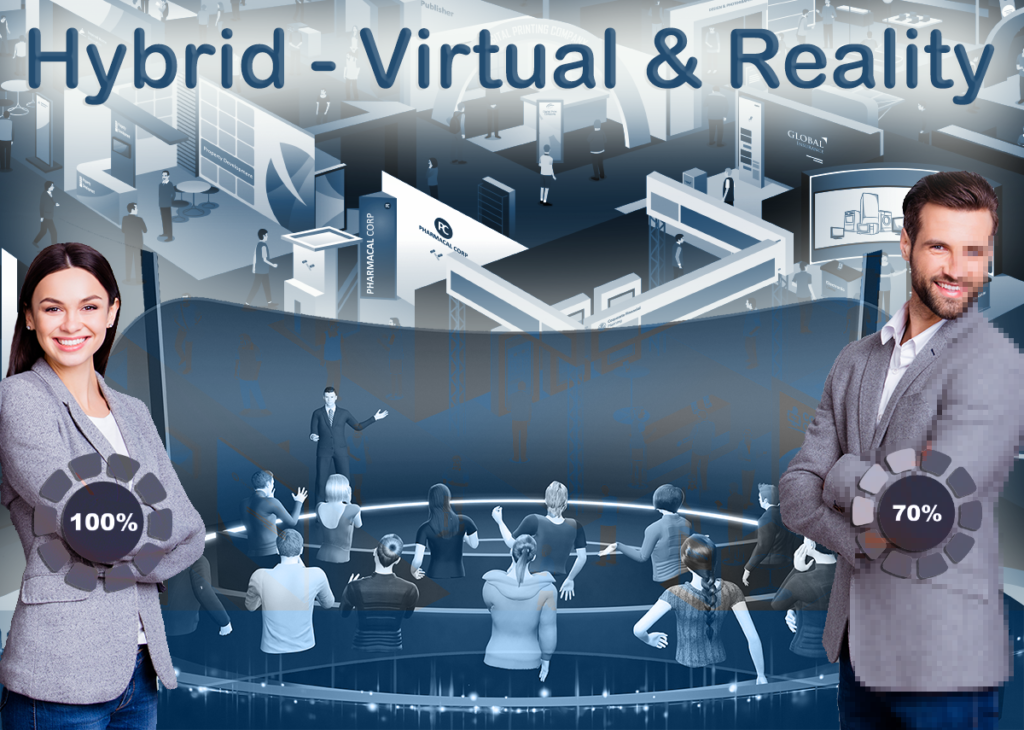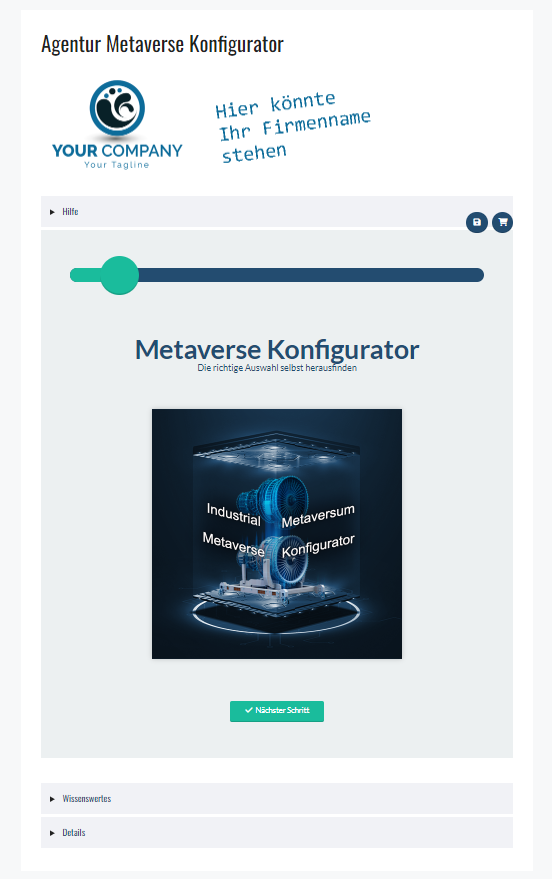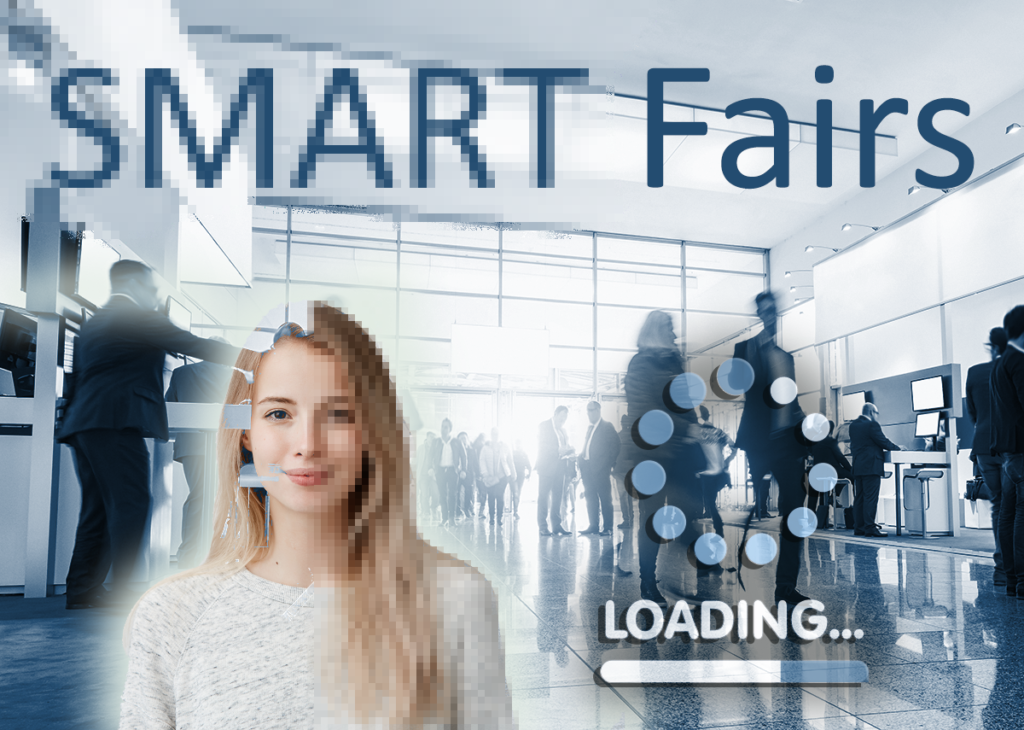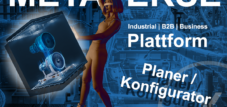Real industrial or B2B business metaverse? When it's a flop 👎🏻 or top 👍🏻!
Language selection 📢
Published on: June 7, 2023 / update from: June 9, 2023 - Author: Konrad Wolfenstein

Real metaverse when virtual and physical worlds merge - Image: Xpert.Digital / Gorodenkoff|Shutterstock.com
When is the Metaverse 'real' and not a 'toy'?
Only a metaverse that includes all devices, including touchscreen tables, is a real metaverse. The playful connection of the virtual and physical worlds.
Yes, a comprehensive metaverse that includes all types of devices and interfaces can be considered a true metaverse. This would enable seamless integration of various devices such as PCs, smartphones, VR headsets and even touchscreen tables. By connecting virtual and physical worlds, such a metaverse could offer a new level of interaction and collaboration.
Touchscreen tables offer an intuitive and interactive user interface that allows users to control content and functions in a fun and intuitive way. In a broader metaverse, touchscreen tables could serve as a part of the overall experience, allowing users to place physical objects on the table and interact with them in the virtual environment.
This kind of playful connection of the virtual and physical worlds can increase user immersion and engagement. For example, in a virtual conference room, users could view information, take notes, or manipulate virtual objects on a touchscreen table. This would create an additional dimension for collaboration and interaction.
A comprehensive metaverse that includes all devices opens up new possibilities for applications in diverse areas such as education, business, entertainment and more. It can provide an enhanced form of collaboration, learning and experience that blurs the boundaries between the virtual and physical worlds, creating a seamless and immersive experience.
➡️ However, it is important to note that developing such a comprehensive metaverse may pose technological and infrastructural challenges. Bringing together different devices and interfaces requires seamless integration and compatibility to ensure a smooth and consistent user experience. In addition, aspects such as data protection, security and accessibility must also be taken into account to create an inclusive and trustworthy metaverse.
The agency online metaverse configurator
For media professionals, 3D artists, online, media and advertising agencies and other service providers: Take advantage of the opportunity to offer your customers their own metaverse by drawing on the expertise of Xpert.Digital and its partners. In addition, you can integrate our Metaverse configurator into your service offering as a white label solution.
More about it here:
The Metaverse as a collaboration tool for presentations, meetings and events is too small
The Metaverse (or Metaverse) is often viewed as a potential future virtual universe that represents an expanded form of reality. It provides an immersive and interactive virtual environment where people can communicate, interact and perform various activities. Although the Metaverse can be considered a platform for collaboration and virtual meetings, there are a few factors that explain why it may be undersized as a collaboration tool for presentations, meetings and events:
Limited accessibility
Access to the metaverse is currently limited. It requires special hardware, such as virtual reality headsets, to fully immerse yourself in the virtual environment. Not everyone has access to this technology, and this may limit participation in virtual meetings and events in the metaverse.
Technical challenges
The Metaverse is a complex technological platform that requires powerful infrastructure to function smoothly. This can present challenges in terms of connectivity, latency and stability, especially when many users are participating at the same time.
Limitations on interaction
Although the Metaverse provides an immersive environment, there are still limitations to how people can interact with each other. In virtual meetings and presentations, the nonverbal communication that occurs in face-to-face meetings, such as gestures or eye contact, may be limited.
Variety of collaboration tools
There are already a variety of established tools and platforms for virtual meetings and presentations that are widely used in the business world. These tools often offer a wide range of features and integrations specifically tailored to collaboration and communication needs.
➡️ Although the metaverse has the potential to revolutionize the way people work together, it is important to consider current technological challenges and limitations. It can be considered a complementary or alternative tool for certain use cases, but it may not be suitable for all forms of collaboration and communication. It remains to be seen how the metaverse will develop in the future and how it can be integrated into the business world.
When the augmented reality of the metaverse is limited only to the virtual world
➡️ In many cases, however, augmented reality in most metaverses focuses primarily on virtual elements and largely neglects the inclusion of the physical world.
A fundamental feature of metaverses should be the integration of virtual and physical worlds to provide users with a rich and immersive experience. While virtual elements such as avatars, digital environments and virtual interactions play a central role, it is equally important to incorporate the physical world to create a truly immersive metaverse.
The integration of the physical world can be done in different ways. One possibility is to integrate real objects and environments into the virtual environment, for example by using augmented reality technologies. This allows users to view and interact with virtual content in their real-world environment.
Another aspect is the consideration of physical actions and interactions in the virtual environment. This could include, for example, the use of gesture control, haptic feedback, or even the integration of physical devices such as VR controllers or other input devices.
In addition, aspects such as geographical and spatial information can also be integrated into the virtual world. This enables, for example, the exploration of real places in virtual form or the linking of virtual events with physical locations.
Incorporating the physical world into metaverses opens up new possibilities for applications in areas such as education, tourism, e-commerce and much more. It allows users to bridge the virtual and real worlds, creating a holistic and multi-layered experience.
It is important to note that integrating the physical world into metaverses may pose technological challenges and privacy issues. Seamlessly connecting virtual and physical elements requires robust technologies, interoperability and clear policies to protect user privacy.
Ultimately, it's about finding a balance between virtual and physical elements to create a truly immersive metaverse that immerses users in a new dimension of experience and interaction.
The Metaverse as a purely virtual communication chat is a flop
The Metaverse as a virtual communication chat may have certain challenges and limitations that may make it appear to be a less successful tool. Here are some possible reasons why the Metaverse as a virtual communication chat could be considered a flop:
Complexity of use
The metaverse often requires specialized hardware and software to be fully utilized. This can be a hurdle for many users who may not have the necessary technology or be unwilling to put in the extra effort to gain access to the metaverse.
Lack of usability
The interface and controls in the Metaverse can be complex and require a learning curve. Users may need to familiarize themselves with new features, menus, and settings to effectively use the Metaverse. This can cause users to become frustrated and lose interest in using the metaverse as a communication tool.
Limited interaction options
In virtual chats in the metaverse, interaction options can be limited. Communication often occurs via text messages or predefined gestures, which may not allow for the same level of personal interaction and expression as in a physical environment or in traditional chat applications.
Limited user base
The Metaverse may not have reached a large user base yet, resulting in a limited number of people to interact with in the virtual chats. This can leave users feeling like the metaverse doesn't offer enough activity or variety to meet their communication needs.
Competition from established platforms
There are already a variety of established communication tools and chat applications that are widely used and have a wide user base. These platforms often offer a simple and user-friendly communication experience with many features and integrations, which can make the metaverse less attractive as a virtual communication chat.
➡️ It is important to note that the potential of the metaverse and its areas of application are still being further researched and developed. Although it may not achieve the desired success as a virtual communication chat, it could provide greater benefit in other areas such as virtual events, collaborative work or virtual training.
When is a metaverse 'real'?
“Real” in the sense of the meta verse refers to the fact that the virtual world and the interactions and experiences experienced in it appear authentic and convincing for the users. A real meta verse should offer a high immersion and give users the feeling of actually being present in a virtual environment.
This means that the virtual world in the Metaverse should have realistic and vivid visual effects, sounds and animations. Users should be able to move freely in the virtual environment and interact with other users and with the objects and elements in the environment. This can be achieved, for example, by using advanced graphics technology, haptic feedback and realistic audio effects.
In addition, a true metaverse should enable a high level of social interaction. Users should be able to connect, communicate and perform collaborative activities with other users in real time. This can be enabled through voice and text chat, avatars and virtual meeting points that promote a shared experience in the virtual world.
A true metaverse should also offer a wide range of uses beyond pure entertainment. It can be used for education, business meetings, collaboration, artistic displays, virtual events and much more. Users should be able to create their own content, share and interact with others to create a dynamic and constantly evolving virtual world.
Overall, a true metaverse is about creating an immersive, interactive and diverse virtual environment that offers users a unique and enriching experience. It should have the potential to promote new forms of collaboration, communication and creativity and blur the boundaries between the real and virtual worlds .
Therefore, a metaverse is only complete and real when 2D matrix code, WebAR, virtual and physical trade fairs, events and showrooms, as well as all devices from smartphones to touchscreen tables come together.
Yes, a comprehensive metaverse that includes all of the elements you mentioned can be considered a complete and diverse metaverse. Here is a summary of the key features that could be included in such a metaverse:
2D matrix codes
The use of 2D matrix codes, such as QR codes, allows users to launch information or interactions in the virtual environment. By scanning the code with a device, such as a smartphone, virtual content can be displayed or certain actions can be triggered.
More about it here:
WebAR
WebAR stands for augmented reality (AR) on websites and allows users to experience AR experiences directly from their web browser without the need to download a special app. This allows for wider accessibility and interaction with AR content across different devices.
More about it here:
Virtual and physical trade fairs, events and showrooms
A comprehensive metaverse can provide the ability to create virtual trade shows, events, and showrooms where users can participate both virtually and physically. Virtual participants can access the virtual rooms via their devices and interact with other participants, while physical participants participate in the events on site.
Suitable for:
Integration of all devices
An important feature of a comprehensive metaverse is the seamless integration and support of all devices, from smartphones to touchscreen tables. Users can use their preferred devices to access and interact with the virtual environment, whether it is a handheld device, a VR headset or a touchscreen table.
➡️ Such a comprehensive metaverse can improve interactivity, collaboration and immersion in virtual spaces and expand the possibilities for various use cases. It can provide an expanded form of communication, learning, marketing and experience by combining virtual and physical elements and bringing users together in a diverse and immersive environment.
➡️ However, it is important to note that developing a comprehensive metaverse that integrates all of these elements can be challenging as it requires different technologies, platforms and infrastructure that must interact seamlessly with each other. Providing a smooth user experience, privacy and security aspects also need to be considered to create a successful and trustworthy metaverse.
Example of hybrid measurements - the fusion of physical and virtual elements in a metaverse

Hybrid trade fairs: The planning and organization of hybrid trade fairs (virtual & reality) – Image: Xpert.Digital
Hybrid trade fairs that take place in combination with metaverses offer a promising concept for the future of the event industry. By combining physical and virtual elements, they open up new possibilities and expand the reach of trade fairs and events on a global or cross-border level .
Here are some important aspects that make hybrid trade fairs combined with metaverses a promising vision for the future:
Global or cross-border participation
By integrating metaverses, hybrid trade fairs can reach a wide audience, regardless of geographical restrictions. Participants from all over the world can take part in the trade fair virtually and access exhibitors, products and presentations on virtual platforms. This enables global networking and opens up new business opportunities across geographical boundaries.
Advanced interaction options
Metaverses offer a variety of tools and features that improve attendee interaction and engagement at hybrid trade shows. Virtual avatars allow participants to move around the virtual environment, communicate with other visitors and take part in interactive presentations. Virtual chats, video calls and networking tools promote exchange and collaboration between participants, similar to a physical trade fair.
Flexibility and accessibility
Hybrid trade fairs combined with metaverses offer flexibility and accessibility for participants. Virtual platforms allow participants to attend the trade fair around the clock, regardless of time and place. This makes participation easier for people with different schedules and reduces travel costs and other logistical challenges associated with physical events.
Presentation options
With the help of metaverses, exhibitors and presenters can find innovative ways to present their products and services. Virtual showrooms enable interactive presentations, 3D representations of products and immersive experiences for participants. By integrating 2D matrix codes and WebAR, visitors can also access information directly on their mobile devices and interact with virtual content.
Cost and resource efficiency
Hybrid trade fairs in metaverses also offer advantages in terms of cost and resource efficiency. Organizers can reduce costs for rental space, setting up and dismantling trade fair stands as well as travel and accommodation costs. At the same time, exhibitors can expand their presence at various trade fairs without having to set up physical locations. This enables more efficient use of resources and better cost control.
Suitable for:
- Marketing strategy hybrid trade fairs: The planning and organization of hybrid trade fairs 4.0 – Hybrid = Virtual & Reality
- Hybrid trade fairs & smart fairs/events: The type and execution of trade fairs are changing
- Hybrid trade fair: trade fair event digital & real – the new trade fair marketing management for event managers
Consulting, planning and implementation of Augmented Reality, WebAR and Industrial | B2B | Business Metaverse (Metaverse)
Xpert.Plus is a project from Xpert.Digital. We have many years of experience in supporting and advising on (Extended) Augmented Reality and in warehouse optimization , which we bundle in a large network under Xpert.Plus .
I would be happy to serve as your personal advisor.
You can contact me by filling out the contact form below or simply call me on +49 89 89 674 804 (Munich) .
I'm looking forward to our joint project.
Xpert.Digital – Konrad Wolfenstein
Xpert.Digital is a hub for industry with a focus on digitalization, mechanical engineering, logistics/intralogistics and photovoltaics.
With our 360° business development solution, we support well-known companies from new business to after sales.
Market intelligence, smarketing, marketing automation, content development, PR, mail campaigns, personalized social media and lead nurturing are part of our digital tools.
You can find out more at: www.xpert.digital – www.xpert.solar – www.xpert.plus


























